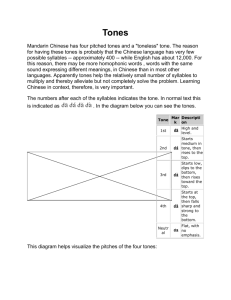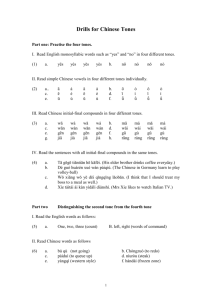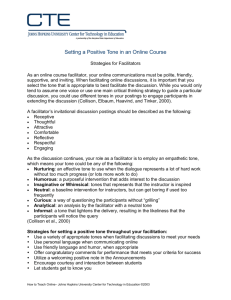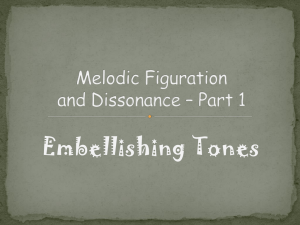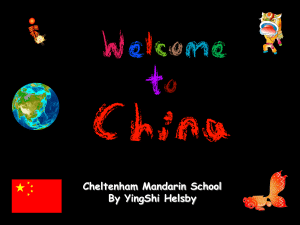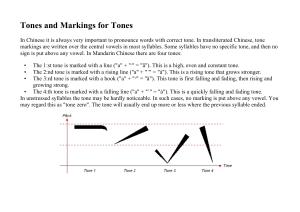Are there any effective approach to teach tones
advertisement
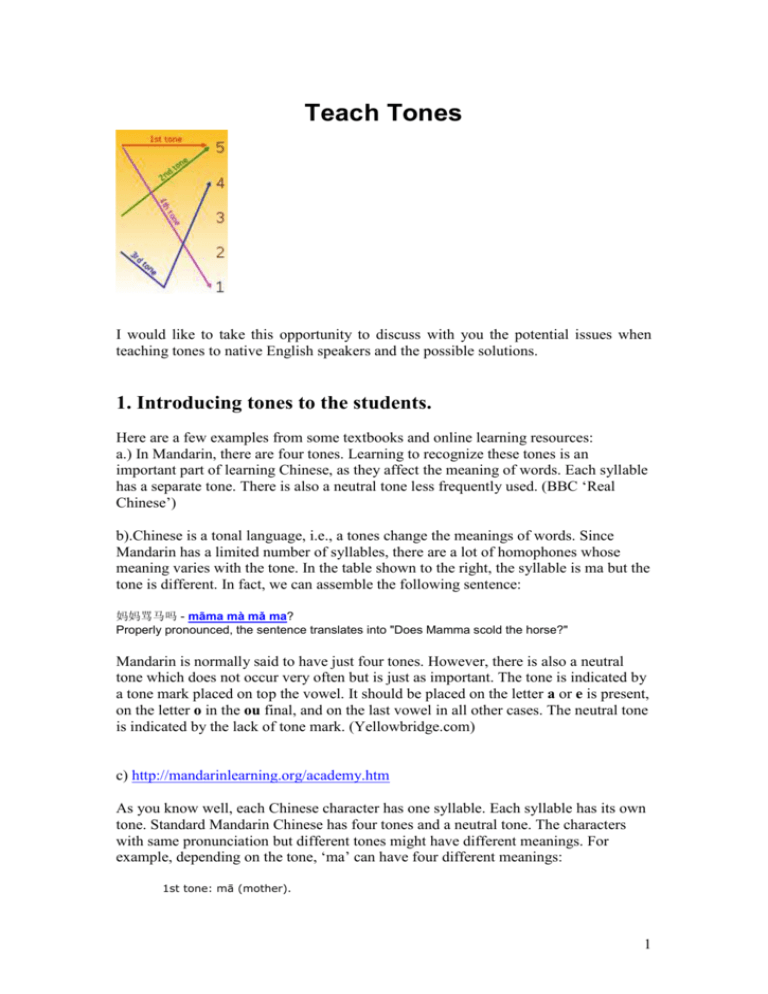
Teach Tones I would like to take this opportunity to discuss with you the potential issues when teaching tones to native English speakers and the possible solutions. 1. Introducing tones to the students. Here are a few examples from some textbooks and online learning resources: a.) In Mandarin, there are four tones. Learning to recognize these tones is an important part of learning Chinese, as they affect the meaning of words. Each syllable has a separate tone. There is also a neutral tone less frequently used. (BBC ‘Real Chinese’) b).Chinese is a tonal language, i.e., a tones change the meanings of words. Since Mandarin has a limited number of syllables, there are a lot of homophones whose meaning varies with the tone. In the table shown to the right, the syllable is ma but the tone is different. In fact, we can assemble the following sentence: 妈妈骂马吗 - māma mà mǎ ma? Properly pronounced, the sentence translates into "Does Mamma scold the horse?" Mandarin is normally said to have just four tones. However, there is also a neutral tone which does not occur very often but is just as important. The tone is indicated by a tone mark placed on top the vowel. It should be placed on the letter a or e is present, on the letter o in the ou final, and on the last vowel in all other cases. The neutral tone is indicated by the lack of tone mark. (Yellowbridge.com) c) http://mandarinlearning.org/academy.htm As you know well, each Chinese character has one syllable. Each syllable has its own tone. Standard Mandarin Chinese has four tones and a neutral tone. The characters with same pronunciation but different tones might have different meanings. For example, depending on the tone, ‘ma’ can have four different meanings: 1st tone: mā (mother). 1 2nd tone: má (hemp) 3rd tone: mă (horse) 4th tone: mà (to scold) Neutral tones: There are some Chinese syllables are toneless, you will not see a tone mark over the vowel for these words. They are like unstressed syllables in English, such as “ three in a row”. Discussion: what else do you think that should be included in the introduction to make your students more aware of the importance of the tones. How do you normally initially introduce the tones to class? 2. I would like to share with you some activities I use to initially present and teach the tones. Discussion: I would like you to quickly discuss with the person next to you and write down the challenges you experience when teaching tones and the possible solutions. a) Play a poem, rhyme, Chinese rap or tongue twister in the class and ask the students to distinguish the tones. i.e. mama ma ma, ma man mama ma ma ma ma ma ma ma ma si shi si, shi shi shi, shisi shi shisi, sishi shi sishi Give and receive the feedback from the students and translate the above into English. b) Drills b-1: During the first few weeks of the class, the students are required to listen to the recordings of two-syllable words and do the repetition in the language lab. There are no English translations given and the students are required to focus on tones only. Get them to do this every lesson for 2-4 weeks. b-2: Detecting tone errors and get students to do the group drills: 2 4-4 rìyuè dàshà pòlì qìnghè yànhuì huàxiàng 日 月 大 厦 破例 庆 贺 宴 会 画 像 shìfàn dàhuì kuàibào zhìyì jiànzào gànbù 示 范 大 会 快 报 致 意 建 造 干 部 4-2 zìrán huàxué cuòcí tèbié diàntái huìtán 自 然 化 学 措 辞 特 别 电 台 会 谈 zhèngquán pèihé wèilái yàowén diàochá biànbié 政 权 配 合 未 来 要 闻 调 查 辨 别 4-1 xiàxiāng kuànggōng xiàngzhēng dì fāng guìbīn liè chē 下 乡 矿 工 象 征 地方 贵 宾 列车 wèixīng rènzhēn jiàng dī t è zhēng yìnshuā qì wēn 卫 星 认 真 降低 特 征 印 刷 气温 4-3 nàijiǔ jùběn tiàosǎn xiàyǔ yùnzhuǎn wàiyǔ 耐 久 剧 本 跳 伞 下 雨 运 转 外 语 bànfǎ xìnyǎng xìqǔ diànyǐng lìshǐ tànxiǎn 办 法 信 仰 2-3 huáběi huánghǎi 华 北 黄 海 qínggǎn miáoxiě 情 感 描 写 戏曲 电 影 历 史 探 险 yáoyuǎn quánshuǐ qínkěn mínzhǔ 遥 远 泉 水 勤 恳 民 主 nánmiǎn míwǎng píngtǎn xuánzhuǎn 难 免 迷 惘 平 坦 旋 转 c) Pick the odd ones out: listen to the recordings and cross out the one, which has a different tone from the others in that set. The statistic show the error rate is high for 3rd tone and 4th tone for native English speakers. So this activity is designed to focus on individual problematic tones. 1) la 2) zhan 3) yao 4) fang da tan dao xue ta lan lao yuan fa dan tao xiao d) You will hear the sets of words illustrated below read out. Listen for differences in the pronunciation of the words in each set. (see hand out- ‘Zhongguotong’1& 2) e) Get the students to work in pairs and each pair is given a set of flash cards with pictures. Teacher will say the words in Chinese and the students must race to pick the correct card. 3 f) Peer correction: record the student’s readings and play the tape in class. Get the students to discuss in small groups and make peer correction. Most students have their individual problematic tones and I found it very effective to ask the rest of the class to give individual students their ideas on tones. You can also invite higher level students to share their experience. g) Using visual aids, i.e. hand gesture, body movement, colours etc. They are very influential methods for different kind of learners. http://www.mdbg.net/chindict/chindict.php?page=worddictbasic&wdqb=%E6%84%8F%E8 %AF%86%E5%BD%A2%E6%80%81&wdrst=0&wddmtm=2&wdeac=1 h)online resources in class and outside class. http://www.shufawest.us/language/tonedrill.html http://www.bbc.co.uk/languages/chinese/games/tones.shtml http://www.ctcfl.ox.ac.uk/Pinyin_Notes.htm#5.%20Tones http://www.yellowbridge.com/chinese/pinyin-rules.php http://www.youtube.com/watch?v=b4gKqjd00E4 tone police This is to allow the student to practise in their own time and progress gradually. 3. Introducing tone changes I would like you to discuss with each other the following: 1) When do you normally introduce the tone change? I normally introduce the following tone changes at the very beginning: 一 不 2) Basic rules for change of the tones. (see handout – 对外汉语教学法 http://clp.arizona.edu/cls/chn/chnpro/mtone/mtone.htm 3) Test: what are the correct tones for the following words? 一直 因为 仍然 法国 兄弟 言语 张亚军) 运气 Discussion: How do you explain the informal tone changes among the native speakers? I normally use authentic visual-audio material to see if the students can notice independently and come out with questions for the tone changes. But this is normally done at a later stage. 4 5 Summary-I would include the following information when I start introduce the tones: There are 47,923 Chinese characters but only 419 initial-final compounds (sound combinations). It is common that same initial-final compound with different tone matches different character. i.e. 妈 mā 麻 má 马 mă 骂 mà 吗 ma Discussion: I would like you to quickly discuss with the person next to you and write down the challenges you experience when teaching tones and the possible solutions. I will give you a couple of minutes. 去去(1_1) 日月 大厦 破例 庆贺 宴会 画像 示范 大会 快报 致意 建造 干部 2、去阳(1_2) 自然 化学 措辞 特别 电台 会谈 政权 配合 未来 要闻 调查 辨别 //2、去阳(1_-2) // 自然 化学 措辞 特别 电台 会谈 // 政权 配合 未来 要闻 调查 辨别 3、去阴(1_3) 下乡 矿工 象征 地方 贵宾 列车 卫星 认真 降低 特征 印刷 气温 4、去上(1_4) 耐久 剧本 跳伞 下雨 运转 外语 办法 信仰 戏曲 电影 历史 探险 //4、去上(1_-2) // 耐久 剧本 跳伞 下雨 运转 外语 // 办法 信仰 戏曲 电影 历史 探险 //去上(1_2) 这样的组合不存在,这是因为普通话的读音习惯是前高后低 5、阳去(2_1) 豪迈 辽阔 模范 林业 盘踞 局势 革命 同志 局势 雄厚 行政 球赛 //5、阳去(-2_1) // 豪迈 辽阔 模范 林业 盘踞 局势 // 革命 同志 局势 雄厚 行政 球赛 6、阳阳(2_2) 直达 滑翔 儿童 团结 人民 模型 联合 驰名 临时 吉样 灵活 豪华 //6、阳阳(-2_-2) // 直达 滑翔 儿童 团结 人民 模型 // 联合 驰名 临时 吉样 灵活 豪华 //6、阳阳(2_-2) // 直达 滑翔 儿童 团结 人民 模型 // 联合 驰名 临时 吉样 灵活 豪华 //阳阳(-2_2)这样的组合不存在,这是因为普通话的读音习惯是前高后低 7、阳阴(2_3) 国歌 联欢 革新 南方 群居 农村 长江 航空 围巾 营私 原封 图书 //7、阳阴(-2_3) // 国歌 联欢 革新 南方 群居 农村 // 长江 航空 围巾 营私 原封 图书 8、阳上(2_4) 华北 黄海 遥远 泉水 勤恳 民主 6 情感 描写 难免 迷惘 平坦 旋转 //8、阳上(-2_4) // 华北 黄海 遥远 泉水 勤恳 民主 // 情感 描写 难免 迷惘 平坦 旋转 9、阴去(3_1) 庄重 播送 音乐 规范 通信 飞快 单位 希望 欢乐 中外 失事 加快 10、阴阳(3_2) 资源 坚决 鲜明 飘扬 新闻 编排 发言 加强 星球 中国 签名 安全 //10、阴阳(3_-2) // 资源 坚决 鲜明 飘扬 新闻 编排 // 发言 加强 星球 中国 签名 安全 11、阴阴(3_3) 参加 西安 播音 工兵 拥军 丰收 香蕉 江山 咖啡 班车 单一 发声 12、阴上(3_4) 批准 发展 班长 听讲 灯塔 生产 艰苦 歌舞 公款 签署 根本 方法 13、上去(4_1) 改造 舞剧 主要 访问 考试 想象 土地 广大 写作 典范 选派 讲课 14、上阳(4_-2) 指南 普及 反常 谴责 讲完 朗读 考察 里程 起航 软席 领衔 党员 //上阳(4_2)这样的组合在正常的情形下普通话没有这样的朗读,除了在特别强调的口气//下 15、上阴(4_3) 指标 统一 转播 北京 纺织 整装 掌声 法医 演出 广播 讲师 取消 16、上上(2_-2) 古典 北海 领导 鼓掌 广场 展览 友好 导演 首长 总理 感想 理想 //上上(2_2)如果后面紧接着仍然是上声则前两个上声读高升调(2_2)成(2_2_4),如“古//典小说”读“古 2 典 2 小 4 说 3” 17、第六调型(-3) 刀子 dāozi-3 车子 chēzi-3 孙子 sūnzi-3 丫头 yātou-2 后头 hòutou-2 胳膊 gēbo-2 抽屉 chōuti-3 姑娘 gūniang-2 师傅 shīfu-3 苍蝇 cāngying-3 哆嗦 duōsuo-3 他们 tāmen-2 朋友 péngyou-2 记得 jìde-2 心思 xīnsi-3 知识 zhīshi-3 扎实 zhāshi-2 那边 nàbian-3 在乎 zàihu-3 模糊 móhu-2 月亮 yùeliang-3 似的 shìde-3 亲家 qìngjia-3 便宜 biányi-2 别扭 bièniu-2 直溜 zhíliu-3 硬朗 yìnglang-2 兄弟 xiōngdì([名]哥哥和弟弟) 兄弟 xiōngdi([名]弟弟) 能干 能干 nénggà ([形]有才能,会办事) néngga ([形]心灵手巧;精明) 言语 言语 yányǔ ([名]指所说的话) yányu ([动]开口;招呼) 运气 yùnqì (词组。武术、气功的一种炼身方法) 7 运气 yùqi ([名]幸运) As you know well, each Chinese character has one syllable. Each syllable has its own tone. Standard Mandarin Chinese has four tones and a neutral tone. The characters with same pronunciation but different tones might have different meanings. For example, depending on the tone, ‘ma’ can have four different meanings: 1st tone: mā (mother). 2nd tone: má (hemp) 3rd tone: mă (horse) 4th tone: mà (to scold) Neutral tones: There are some Chinese syllables are toneless, you will not see a tone mark over the vowel for these words. They are like unstressed syllables in English, such as “ three in a row”. This is how we normally introduce the tones to the beginner learners on most textbooks, ‘TONES ARE VERY IMPORTANT AS WRONG TONE CAN CAUSE THE MISUNDERSTANDING. Do you agree? 1. Are there any effective methods to teaching tones? I will demonstrate some activities for discussion. 2. coloured coding as a visual aid Activity 1 drills: during the first week of the class, the students are required to listen to the recording and copy the pronunciation correctly. There are no English translations on the handout and the students are required to focus on tones only. 8 Activity 2: You will hear the set of words illustrated below read out. Listen for differences in the tones in each set. (‘Zhongguotong’) Let’s discuss the following issues: 1) What is the aim of this activity? (To raise the awareness of the importance of learning tones.) 2) Are there any advantages and disadvantages ? Activity 3: Take the odd out The stastic show the error rate are high for 3rd tone and 4th tone for native English speakers. So this activity is designed to train the students to distinguish the 3rd tone and 4th tone. P14 Activity 4: record the readings and listen to the tape in class. Discuss in small groups and make peer corrections. Activity 5: using online resources in class and outside class. http://www.shufawest.us/language/tonedrill.html This is to allow the student to practise at their own time gradually as grasping the tones can not be succeeded in one day! Activity 6: use rap (shuo chang-Chinese hip pops) Besides, body language and colour coding also help the learners to grasp the tones. For example MDGB has coloured coding on their web page which give each tone an individual colour. This visual aids give students especially the young learner a great help! Using the resourse from the students: how the successful learners to memorize the tones? Do they try to associate the tones with sounds in their mother tongue? What is the correct tones? Dictionary? Reng ran cuole zenme ban? Do we have to restricted the correct tones? Or there are some spaces. E.g. gu li / gu li / reng ran / reng ran 9 10) Ningin: How did you come up with the system of colors and tones? Nathan: I started using it when I was first studying Chinese while still living in Japan, because I am a rather visual learner and it seemed like a systematic way to remember the tones (which are very easy to forget for native speakers of non-tonal languages). I thought the idea could be used in Chinese as a Foreign Language (CFL) classes at all different levels so I wrote the book. Ningin: What are advantages to this learning system? Nathan: Much has been written about the importance of tones in Mandarin. Without proper production skills, the learner of Chinese will at best sound strange and foreign to a native listener, and at worst be utterly misunderstood. I think there are a number of approaches to teaching Mandarin tones to CFL students, ranging from the idea that students will simply “pick up” the tones intuitively, or “musically” as they study the language, to rigorous programs like Princeton’s that focus solely on pronunciation for the first couple of months. As both a teacher and a learner of the language, I am of the opinion that a student needs to make a consicous effort to recognize and produce the tones, and an important aspect of that is of course remembering which tone is which. I hope that my system gives a context, even for non-visual learners, for distinguishing between the four tones in Mandarin and providing a mnemonic system to help them remember which tone goes with a particular word. This is especially important because - unlike written languages that use an alphabet - Chinese characters themselves provide little to no phonetic information. Ningin: Is this applicable to learning any other languages? Nathan: I suppose it could be applied to any other tonal language (Thai, Vietnamese, and other Chinese languages such as Cantonese) by simply adding more colors as needed. It’s convenient that Mandarin only has four tones, which is a relatively small number. Ningin: With so many characters in the Chinese written language, do you plan on sequel books? Nathan: I hope so! I would love to do a second book with the next 100 or so characters, and I’ve started writing a different version for a Japanese audience. Learning Chinese Through Tone & Color comes with two CDs with both audio and images for mp3 players. Illustrated by Dan Acton. Published by Hippocrene Books and for sale online at Amazon or Barnes and Noble. http://blog.ningin.com/2008/10/16/learning-chinese-through-tone-color-and-nathandummitt/ 10 think, while teaching the tones, hand gestures mimiccing the tone marks may be helpful Good idea or bad idea argument: No, because then whenever you talk, you end up looking like you're conducting an orchestra. This is not a habit you want to form. Tones Mandarin Chinese has four pitched tones and a "toneless" tone. The reason for having these tones is probably that the Chinese language has very few possible syllables -- approximately 400 -- while English has about 12,000. For this reason, there may be more homophonic words , words with the same sound expressing different meanings, in Chinese than in most other languages. Apparently tones help the relatively small number of syllables to multiply and thereby alleviate but not completely solve the problem. Learning Chinese in context, therefore, is very important. Can you imagine that the Chinese use only three syllables when expressing the same meaning as each of the following sentences conveys? (Click on each of the sentences to see the corresponding Pinyin with their tones marked. Then click on the speaker icon to listen.) 1. A mother who is riding on a horse thinks that it is slow and so she curses it. 2. A little girl who is herding a cow finds it stubborn and so she pinches it. Now you can understand how the Chinese use only one syllable "da" and yet can tell the difference betwee "to hang over something" ( da1 ), "to answer" ( da2), "to hit" ( ( da4). Yes, the secret lies in the tones. da3), and "big" The numbers after each of the syllables indicates the tone. In normal text this is indicated as . In the diagram below you can see the tones. 11 Motivate Students to Master the Chinese Tones with Chinese Rhythmic Verses 使用节奏汉语激励学生掌握汉语声调 John Jing-hua Yin (印京华) University of Vermont (佛蒙特大学) Learning to pronounce a single Chinese tone may not be challenging as any of the four tones in Mandarin Chinese can be found in English. However, learning to say a Chinese sentence that has a string of syllables with four different tones proves to be a very challenging learning task for American students. The conventional teaching approach has not been stimulating enough to keep our students motivated to learn to speak Chinese with correct tones. After years of our frustration over very minor success in helping students to get their tones right, we found that the reason why our teaching was not as effective as we would it to be is that we failed to understand and utilize the characteristics of Chinese in our teaching. When students do not have much success in mastering Chinese tones, they tend to give up improving their tones. To change this negative trend, we decided to try a new approach that utilizes the melodious and rhythmic nature of the Chinese language. We composed several dozens of rhythmic verses in Chinese and use one of them to begin or conclude each of our first-year and second-year Chinese classes. As each verse has the rhythm that can excite students easily, students enjoy listening and chanting these rhythmic verses. They are better motivated by these enjoyable rhythmic verses, and their pronunciations of Chinese sounds and tones are noticeably better. This paper presentation will focus on how this new teaching and learning approach works, specifically on how we may use Chinese rhythmic verses to motivate students to master the Chinese tones Tone Mark Description 1st High and level. 2nd Starts medium in tone, then rises to the top. 3rd Starts low, dips to the bottom, then rises toward the top. 4th Starts at the top, then falls sharp and strong to the bottom. Neutral Flat, with no emphasis. 12 This diagram helps visualize the pitches of the four tones: The tone of a syllable may change in some situations. For example, these are the characters for "mother" . As separate characters each is pronounced as "ma," but when put together, the second "ma" becomes toneless: . Rules like this are, however, very few and very easy to remember. Created by Haiwang Yuan & Shizhen Gao Last updated: August 22, 2002 10. Learn tones through colour : online aid: MDGB coloured coding for tones The fúwùyuán 服务员 actually have a good reason for repeating back what I order: they want to make sure they got it right. Since I often go many months (years) without using some of this vocabulary, it helps to hear it again right away to confirm whether I got the tones right. Me: suànmiǎo chǎo ròupiàn 蒜苗炒肉片. Garlic seasoned greens and pork slices (see here) Waitress: suànmiáo chǎo ròupiàn, shì ba? 蒜苗炒肉片, 是吧? Garlic seasoned greens and pork slices, right? Me: duì duì duì 对对对. Right, right, right. The first duì was for her getting the order right and the next two were for my realization that I’d said the tone for “miao” wrong. (Those 2-3 combos will get ya! The way I said it made it sound like suànmiao.) 13 It takes some careful listening, but once you know it’s coming (and it usually is), you can prepare for the instant replay and use it. I now purposefully choose words that I’m not sure about just so I can get instant feedback on whether my tones were correct. Of course, the assumption here is that a native speaker will not say it wrong even if I did. I think that’s a pretty safe assumption (usually). Before I knew the rules for tone combinations, and before I’d memorized exactly how to pronounce the name of my country, I would often say I’m from méiguó or mèiguo or méiguǒ rather than měiguó 美国. Those mispronunciations could be hanzi-fied as 没国, 妹国, and 没果 meaning “not country / not-land,” “younger sister country,” and “no fruit,” respectively. The good news is: no Chinese person would ever talk about “Not-land” or “Sisterland” so I was never misunderstood. The context was very much in my favor to allow a Chinese person to understand me despite the wrong tones (not always the case at all!). But I noticed people would often (dare I say always?) repeat the name of my country back to me like this: Stranger: nǐ láizì nǎli? 你来自哪里? Where are you from? Me: méiguó. Not-land. Stranger: měiguó 美国. America. Me: duì 对 Right. Now I say it right most (dare I say all?) the time, but the repeating hasn’t stopped. That’s the last point I want to make: parrot people don’t mean you’ve said it wrong. Chinese Tone Learning Strategies and Tone Competence - An Exploratory Study Abstract: This study investigates the relation between Chinese tone learning strategies and tone competence by adopting a correlational approach. Two instruments are devised for the data collection of this study: Chinese Tone Learning Strategy Questionnaire and Tone Performance Tasks. By performing statistical analyses on the data collected by these two instruments with twentyfive CFL learners, this researcher finds that three groups of Chinese tone learning strategies help to improve tone competence: 1) strategies that are directly related to tone perception; 2) noticing strategies when processing the tonal input; 3) self-monitoring strategies when processing the tonal output. This researcher also finds that kinaesthetic ways of learning Chinese tones, e.g., moving hands when speaking or reading aloud in Chinese, influence tone 14 competence in a negative way. Since there are no previous studies on a similar topic, this study posits itself as being of the exploratory type. 提要:这项研究调查中文声调学习策略与声调能力之间的关系。通过让二十五 个中文学习者填写中文声调学习策略问卷及参加声调能力测验,研究者发现三 类声调学习策略对学习者提高中文声调能力有利,它们是:1)与声调听辨直 接相关的学习策略;2)被动接受声调输入时的主动注意策略;3)声调输出 时的自我监听策略。研究者同时发现通过肢体语言学习声调的方法在声调学习 过程中起反作用。 Tone Competence and Learning Strategies Tones are very important in Chinese phonology since they play a role in word meaning discrimination. Problems in pronouncing Chinese tones can easily cause misunderstanding or failure in oral communication. Therefore, tones are a primary characteristic of Chinese that CFL students need to learn in order to speak this language competently. However, there appears to be a consensus among Chinese teachers and researchers that tones are a major obstacle for Chinese learners in speaking (see Miracle 1989). Why are Chinese tones so difficult for second language learners? The commonly accepted explanation is Critical Period Hypothesis (CPH), which proposes that after a certain critical period of one’s childhood, it is impossible to acquire a second language with native proficiency. Although there is some controversy about CPH in second language acquisition, CPH would seem to be widely acknowledged in the phonology acquisition (see Major 1987). Li and Thompson (1978) reviewed studies of tone acquisition by children in their first language. They found that children actually mastered the tone system of a language at a very early stage. For example, there was a case in which native Chinese children started to pronounce tones in their speech at the early stage of linguistic development, when they could say only a few words. At the next stage, when they could form simple sentences, they were able to pronounce all tones correctly. Li and Thompson also found that the tone system was acquired by children before the segmental system 1 of a language. Li and Thompson believed it was because children were especially sensitive to reproduce pitch variations. Within the critical period, children acquire the ability to use tones even earlier than other sounds, a fact which may go some way towards explaining why tones are more difficult to master than the segmental parts of a language for second language learners. There is therefore an obvious need for more pedagogical insights in direct relation to the facilitation of Chinese tone learning by CFL adult learners. As early as in 1976, Stevick pointed out that phonology acquisition for second language learners involved not only neuromuscular ability, but also required cognitive 1 Segmental system refers to the vowels and consonants of a language. Suprasegmental system refers to the tone, the stress and the intonation of a language (see Katamba 1989). 15 skills. Hammarberg (1993) also addressed a similar issue, proposing that learners of a second language were not passive in phonology acquisition, nor were they controlled by natural constraints; on the contrary, he theorized that they used specific strategies to process the phonology information of a second language. Therefore, research on tone learning strategies and their effectiveness in Chinese tone acquisition bears practical significance on the facilitation of tone learning by CFL learners. The Theory of Learning Strategies The theory of learning strategies has drawn great attention from researchers in the last two decades. Numerous studies have been carried out on the adoption of strategies in various aspects of language learning and language use (see O’Malley and Chamot 1990, Oxford 1990, Macaro 2003). Unfortunately, there is no single uniform definition of learning strategies that has been widely acknowledged in existing literature. A few commonly accepted examples are given below: ‘∙∙∙Learning strategies are the behaviours and thoughts that a learner engages in during learning that are intended to influence the learner’s encoding process. ∙∙∙’ Weinstein and Mayer 1986: 315 ‘∙∙∙Specific actions taken by the learner to make learning easier, faster, more enjoyable, more self-directed, more effective and more transferable to new situations. ∙∙∙’ Oxford 1990: 8 ‘∙∙∙Specific thoughts or behaviours that individuals use to help them comprehend, learn, or retain new information. ∙∙∙’ 16
